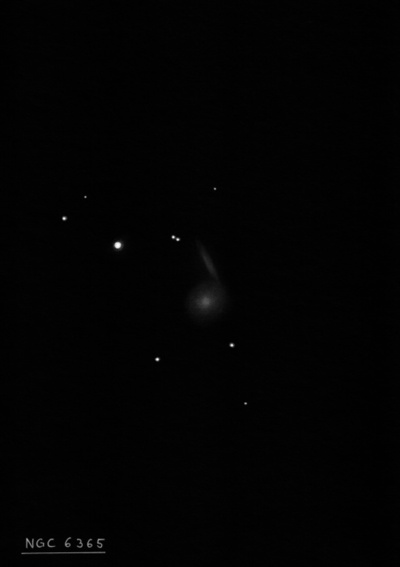
Lewis Swift discovered NGC 6365 = Sw. IV-49 on 15 Aug 1884 and recorded "eeeF; pL; iR; sev eF stars involved; B * nr south-following." There is nothing at his position, though 1.1 minutes of RA due east is Arp 30 = UGC 10832/10833 (double system). The bright star in his description is actually north-following. MCG fails to identify either MCG +10-25-018 or -019 as NGC 6365.
400/500mm - 17.5" (7/16/88): this is a double galaxy (Arp 30) with a separation of 30" oriented NNW-SSE with the brighter component at the SSE end. NGC 6365A is very faint, small, weak concentration, very diffuse. Bracketed by two mag 14 stars off the SW and NE ends. NGC 6365B is attached at the NW end of NGC 6365A and appears extremely faint, small, very elongated SW-NE [1.1x0.2], requires averted vision.
600/800mm - 24" (7/20/17): at 322x and 375x; NGC 6365A appeared fairly faint, fairly small, round, 40" diameter, broad concentration but no definite core or nucleus. This face-on spiral forms an overlapping pair (Arp 30) with NGC 6365B, a low surface brightness edge-on at the northwest edge. The companion appeared extremely faint, very small, elongated ~2:1 SSW-NNE, ~20"x10", extremely low surface brightness. The pair is situated ~1.5' WSW of a mag 10 star that interferes somewhat with viewing. A mag 14/15 double star lies 1' NNE.
24" (6/28/16): at 375x; NGC 6365A is the southern and brighter member of Arp 30. At 375x it appeared faint to fairly faint, fairly small, slightly elongated, 40"x35", weak concentration. NGC 6365B (perhaps Arp's "heavy arm"), attached at the northwest edge, appeared extremely faint to very faint, edge-on ~3:1 SSW-NNE, ~30"x10", very low surface brightness so difficult to judge size. A distracting mag 10.2 star is ~1.5' NE and a 6" pair of mag 14-15 stars is 1' NE.
900/1200mm - 48" (5/15/12): NGC 6365A is fairly faint, moderately large, round, ~50" diameter, broad concentration with a brighter core. NGC 6365B is attached at the NW edge and appears faint, edge-on 4:1 NNW-SSE, 0.6'x0.15', low surface brightness, very weak concentration. . The pair is 1.6' SW of a mag 10.2 star that detracts somewhat from viewing. A mag 14-15 pair at 6" separation lies just 1' NNE.
Notes by Steve Gottlieb